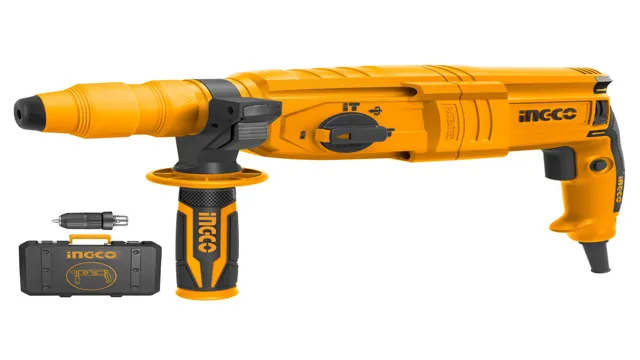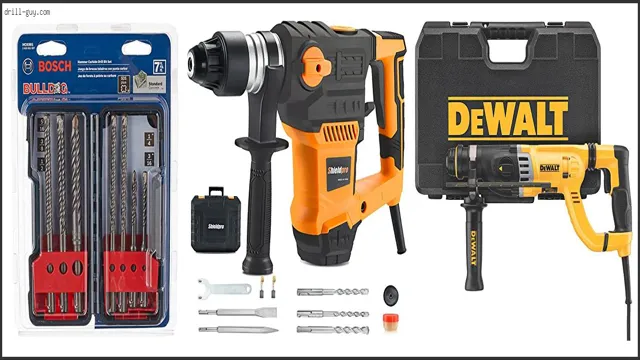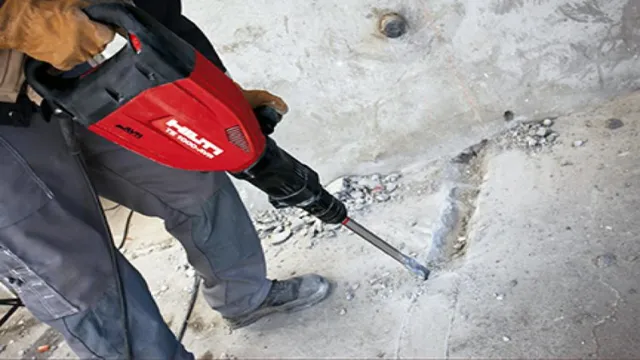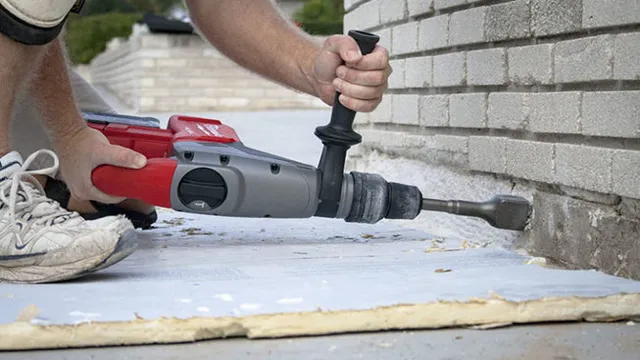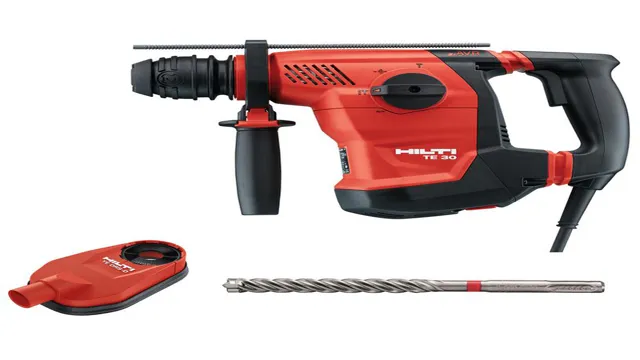How Does a Rotary Hammer Work: Understanding the Mechanics Behind This Powerful Tool
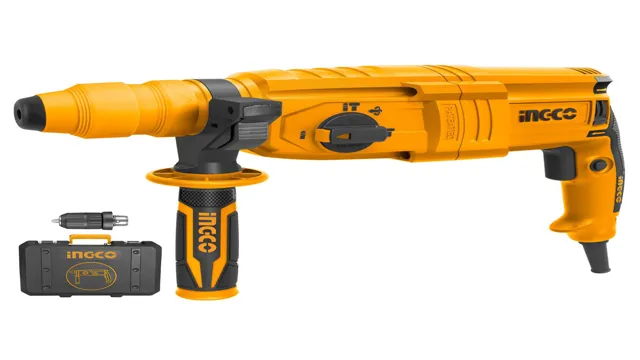
Have you ever wondered how a rotary hammer works? If you’re a DIY enthusiast or a construction worker, you’ve probably used one before. A rotary hammer is a powerful tool that can make any drilling job easier. But how does it work exactly? It’s important to understand the mechanics behind it to use it effectively and safely.
In this blog, we’ll take a closer look at how a rotary hammer works and why it’s a must-have in any toolbox. We’ll break down the process and explain the difference between a rotary hammer and a regular drill. So whether you’re a seasoned pro or a DIY beginner, keep reading to learn all about rotary hammers and how they can make your job easier.
Introduction to Rotary Hammers
Have you ever wondered how a rotary hammer works? A rotary hammer is a powerful tool used primarily in construction and renovation projects. It is designed to drill holes through hard materials like concrete, masonry, and stone. Unlike a traditional hammer drill, a rotary hammer uses a combination of rotation and percussive force to create a powerful impact.
It achieves this by using a piston that moves back and forth inside a cylinder, which compresses air and delivers a powerful blow to the drill bit. The result is a tool that can handle heavy-duty drilling tasks with relative ease. Whether you’re a professional contractor or a DIY enthusiast, a rotary hammer is a valuable addition to your toolbox.
Function of a Rotary Hammer
Rotary hammers are powerful tools known for their ability to drill into even the toughest materials such as concrete and masonry. These tools have an impact mechanism that operates by combining the rotational motion of a drill with high-frequency hammering action. This allows the user to drill holes and drive screws with ease as it delivers a consistent and powerful force to the surface being worked on.
With the ability to switch between drill and hammer modes, rotary hammers are a versatile tool suitable for various applications, from construction sites to DIY projects. With a range of attachments and accessories available, the rotary hammer can also function as a chisel, variable speed drill, and a percussion drill. The adjustable depth gauge on the rotary hammer helps to ensure precise drilling depth.
Overall, the rotary hammer is an excellent choice for heavier drilling tasks that require precision and efficiency.

Rotary Hammer vs Hammer Drill
When it comes to drilling in tough materials like concrete, bricks, or stone, you need a tool that can handle the job. This is where a rotary hammer comes in. Unlike a regular hammer drill, which simply applies force and rotation to a drill bit, a rotary hammer uses a piston-driven mechanism that delivers a powerful punch to the bit, allowing it to drill through even the toughest materials with ease.
The key advantage of a rotary hammer is its ability to create holes of larger diameters and depths, making it ideal for heavy-duty drilling tasks. Whether you’re a professional contractor or a DIY enthusiast, a rotary hammer is an essential tool that can save you time and effort on your projects. So, the next time you’re looking for a durable, reliable drill that can handle the toughest jobs, consider investing in a rotary hammer.
Components of a Rotary Hammer
A rotary hammer is a specialized tool commonly used in construction and DIY projects that requires drilling through hard surfaces. This tool offers extra power compared to a traditional drill and can bore through tough concrete and masonry. The hammering motion distinguishes rotary hammers from the standard hammer drill, which only rotates.
The rotary hammer uses a piston driven by an electric motor, which compresses air within a cylinder. The compressed air then moves the piston forward, driving the bit into the material. The hammering action occurs when the piston hits the end of the cylinder and bounces back, striking the bit repeatedly in a rapid motion.
To ensure the safety of the user and precision of the hole, most rotary hammers come with depth gauges that control the depth of the hole to be drilled. Finally, to provide a comfortable grip for the user, rotary hammers come with handles made from ergonomically designed materials that reduce vibrations.
The Motor
A vital component of a rotary hammer is its motor. It is the power behind the tool that drives the drill bit through hard materials. Hammers come with various motor power ratings, which determine their performance.
The higher the power rating, the more powerful the motor and the harder the material it can drill through. The motor also plays a crucial role in determining the drilling speed and efficiency of the hammer. It is essential to choose a hammer with a motor that matches the user’s needs and the job requirements to achieve the best possible results.
When considering a hammer’s motor, take note of its voltage, amperage, and wattage to know its power and capabilities. Additionally, some hammers come with brushless motors that deliver high efficiency and performance while reducing wear and tear. Overall, the motor is the heart of a rotary hammer and a critical factor to consider when selecting the right tool for the job.
The Hammering Mechanism
A rotary hammer is a versatile tool that is used for drilling holes in tough materials like concrete, stone, and brick. The hammering mechanism of a rotary hammer is what makes it different from a regular drill, and it is made up of several key components. The first component is the piston, which provides the power for the hammering action.
The piston is driven by a motor, which is powered by an electric or battery source. The second component is the chuck, which holds the drill bit or chisel in place. The chuck can be adjusted to accommodate different sizes of bits and chisels.
The third component is the impact mechanism, which delivers the hammering action to the bit. This is usually made up of a series of gears and cams that work together to create a high-impact force. Finally, there is the housing, which encases all of the other components and provides a handle for the user to hold onto.
Together, these components make up the hammering mechanism of a rotary hammer and allow it to tackle even the toughest drilling jobs with ease.
The Chuck and Bit
The Chuck and Bit are two essential components of a rotary hammer that work together to make drilling through tough materials a breeze. The chuck is the mechanism that holds the drill bit in place and allows for easy assembly and disassembly of different bits. A keyless chuck is a common feature that makes it easy to change bits without the need for external tools.
On the other hand, the bit is the part of the tool that does all the work. It is engineered with hardened steel to withstand high-speed drilling through tough materials like concrete. There are different types of bits, such as carbide-tipped bits, diamond bits, and chisel bits, each designed to work best with specific materials.
When choosing the right bit for your rotary hammer, consider the material being drilled, the size of the hole needed, and the type of hammer being used. Whether you are drilling through concrete, brick, or stone, having the right chuck and bit combination is key to getting the job done quickly and efficiently.
Using a Rotary Hammer
How does a rotary hammer work? A rotary hammer is a powerful tool that can be used for drilling through tough materials such as concrete, brick, and stone. Unlike a regular hammer drill, a rotary hammer works by combining both rotation and hammering action, creating a more efficient and effective drilling process. The tool is also equipped with a piston mechanism that compresses air, which is then released to generate the hammering impact needed for drilling.
The drill bit is designed to rotate as it hammers, creating a clean and precise hole. With its advanced technology, a rotary hammer is an essential tool for any construction or DIY project that requires drilling through challenging surfaces. So, whether you are drilling through concrete slabs or masonry walls, a rotary hammer can help you get the job done quickly and efficiently.
Safety Precautions
When it comes to using a rotary hammer, there are several safety precautions that you need to keep in mind to ensure a safe and accident-free work environment. Firstly, always wear the appropriate personal protective equipment such as safety glasses, earmuffs, and gloves to protect yourself from flying debris and loud noise. Secondly, make sure to carefully inspect the tool before use, checking for any cracks or defects in the machine or the bits.
Always keep your workspace clear of any obstacles, people, or animals that can potentially cause distractions or accidents. Additionally, ensure that the tool is properly grounded and plugged into a circuit with a ground-fault circuit interrupter (GCFI) to prevent any electrical hazards. Finally, always read the instruction manual before operating a rotary hammer and follow the manufacturer’s recommended guidelines for use and maintenance.
Keeping these safety precautions in mind will help prevent accidents and ensure a safe work environment when using a rotary hammer.
Selecting the Right Bit
When it comes to using a rotary hammer, selecting the right bit is crucial. The bit size and type will depend on the task at hand, so it’s important to choose the appropriate one. For example, if you’re drilling through concrete or masonry, you’ll need a carbide-tipped masonry bit.
However, if you’re working with wood, a standard wood bit will suffice. Additionally, you’ll want to consider the length of the bit. Shorter bits are ideal for shallower holes, while longer bits are better for deeper holes.
It’s also important to check the bit’s compatibility with your rotary hammer. Always ensure that you’re using the correct shank type and size for your tool. By taking the time to select the right bit, you can increase the efficiency of your work and minimize the risk of damage to your rotary hammer or the materials you’re working with.
Conclusion
In conclusion, a rotary hammer is like a superhero of power tools. With its combination of rotary motion and hammering action, it can conquer even the toughest concrete and masonry work with ease. Its secret power lies in its ability to generate immense force and energy in a compact and efficient manner.
So the next time you need to break through a wall or drill into concrete, remember that a rotary hammer is your trusty sidekick, ready to save the day and make your DIY dreams come true.”
FAQs
What is a rotary hammer?
A rotary hammer is a power tool that is used for heavy-duty drilling tasks, such as drilling through concrete and masonry.
How does a rotary hammer work?
A rotary hammer works by using a piston mechanism to create a pounding action as the drill bit rotates. This pounding action allows the drill bit to break through tough materials like concrete.
What are the benefits of using a rotary hammer?
The benefits of using a rotary hammer include its ability to drill through tough materials, its efficiency in completing heavy-duty tasks, and its ability to reduce user fatigue compared to traditional hammer drills.
Can a rotary hammer be used for other purposes besides drilling?
Yes, some rotary hammers come with additional features that allow them to be used for tasks like chiseling and demolition.
How do I choose the right rotary hammer for my project?
When choosing a rotary hammer, consider factors like the materials you will be drilling into, the frequency of use, and the power source (electric vs. cordless).
What safety precautions should I take when using a rotary hammer?
Safety precautions when using a rotary hammer include wearing protective gear like goggles and gloves, ensuring the drill bit is secure before beginning drilling, and being aware of the drill’s power and impact.
How do I maintain my rotary hammer?
To maintain your rotary hammer, regularly clean it of dust and debris, check and replace worn parts as needed, and store it in a dry, secure location when not in use.

